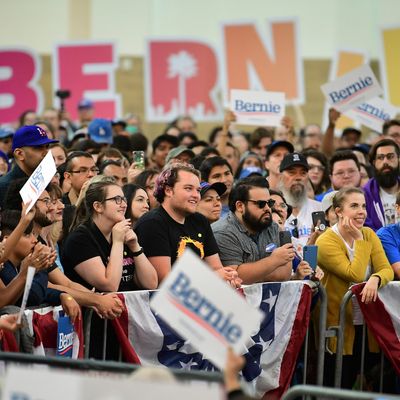
One of the many specters hanging over the 2020 Democratic presidential nomination is the fear that the competition will get so intense that supporters of defeated candidates will stay home next November or vote for minor-party candidates — or even for The Evil One. Fairly or not, this concern is particularly associated with supporters of Bernie Sanders. In part that’s probably because of the crusading nature of his 2016 and 2020 campaigns, which however civil they have been, have regularly if implicitly suggested that rivals are corrupt or timid. But there’s some empirical evidence that after the intermittently bitter 2016 primary fight with Hillary Clinton, a significant number of Sanders voters cast general election ballots for Donald Trump (one large sample study shows 12 percent of them doing so).
One national survey from Emerson College in April found a quarter of Sanders supporters claiming they’d vote for Trump over Elizabeth Warren (that poll should be taken with more than a grain of salt, since it uniquely found Sanders leading Joe Biden nationally by five points). And it’s not hard to find individual Sanders bravos proclaiming to the world that it’s their way or the highway in 2020.
But now Nate Silver has taken a fresh look at the issue from the perspective not of hypothetic votes in a distant general election, but in terms of intensity and exclusivity of support for a candidate in the Democratic field:
A recent YouGov poll, which asked Democrats to list all the candidates they were considering rather than requiring them to pick just one, also seems to suggest that Sanders has a relatively high floor of support. Among Democrats who were considering only one candidate, 28 percent were considering only Sanders, and 27 percent were considering only Biden. Everyone else was in the single digits on this question.
Here’s the catch, though: Only 28 percent of Democrats fell into the category of considering only one candidate. (By comparison, 67 percent are still considering multiple candidates, and 5 percent aren’t considering any current candidates.) So Sanders isn’t getting 28 percent of 100 percent — he’s getting 28 percent of 28 percent. That means just 8 percent of the overall Democratic electorate truly falls into the “Bernie or bust” category.
According to the same standard in the same poll, an equal percentage of Democrats are “Biden or Bust” voters, not considering anyone other than Uncle Joe. Since they are likely on average more moderate or “swingy” than Sanders supporters, you’d figure they might be more likely to defect in a general election if the party does go democratic socialist at the top of the ticket. But you don’t hear much about that possibility, just as you don’t hear Democrats begging Biden (or any other candidates aside from Sanders) to take special care to keep his voters under the party’s big tent.
As the fault lines of the 2020 nominating contest slowly form this year, we should have a clearer idea of how flexible partisans for this or that candidate really are. It could matter a lot in terms of potential coalition-building: flexible supporters might help someone who is otherwise an underdog pull some upsets in the primaries. It would certainly be bad news for Warren if Sanders supporters really are as hostile to her as that Emerson poll suggested.
We should also learn more about what might drive particular groups of Democrats toward a general election defection or abstention. For those terrified by the apparent Sanders-supporter defection rates in 2016, it’s worth observing that they were almost certainly driven by the near-universal assumption that Clinton had the general election in the bag. Unless the 2020 Democratic nominee is leading by 30 points and is poised to win all 50 states, that sort of freedom to cast a protest vote or non-vote without consequences is unlikely to reappear this time around.






























